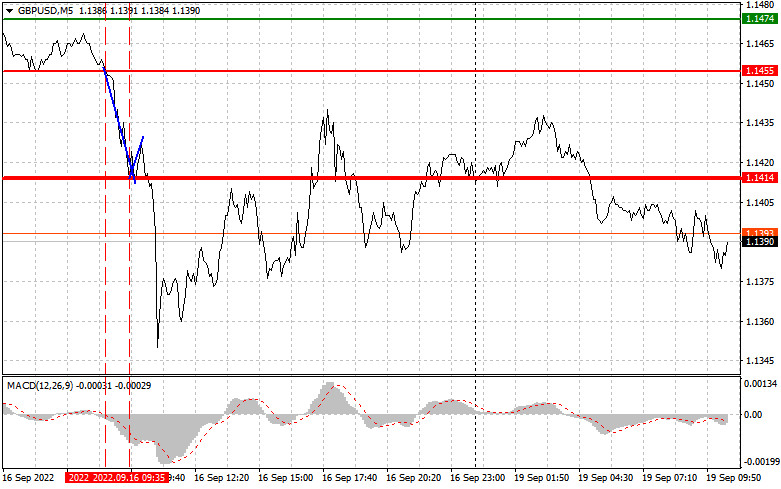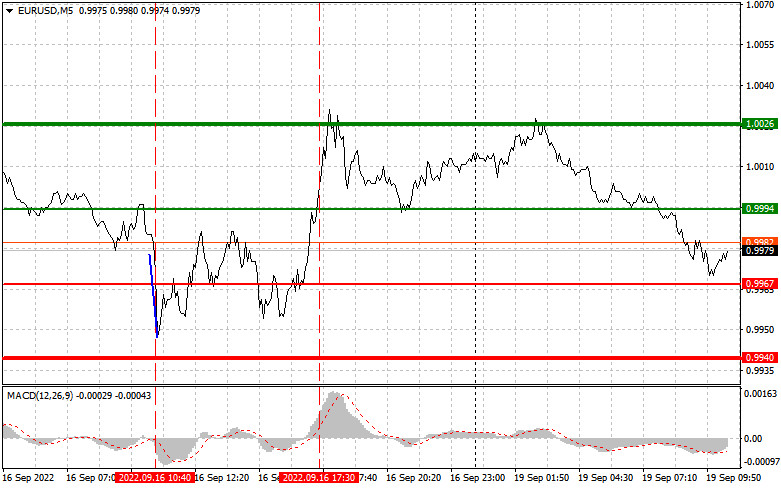
Trading recommendations
The pound/dollar pair tested 1.1455 when the MACD indicator started dropping from the zero level. This confirmed a short signal, which proved the ongoing bearish trend that remained intact during the previous week. As a result, the pair slumped by more than 40 pips. Buy orders from 1.1414 led to a correction of 15 pips. After that, pressure on the pound sterling returned. There were no other signals.

In August, the UK data on retail sales, excluding fuel, caused another massive sell-off of the British currency. It is obvious that the Kingdom's economy is tipping into recession. During the US trade, the pound sterling slightly rebounded amid a decline in the Michigan consumer sentiment indicator.
Today, in the first part of the day, the UK will not disclose any macroeconomic reports. That is why the pound sterling will hardly receive any support. The pair is likely to remain under pressure and continue falling to a new yearly low. In the second part of the day, the US will publish its NAHB housing market index. However, it will hardly affect the market situation. That is why pressure on the pair may increase ahead of the Fed meeting.
Signals to buy GBP
Scenario 1: Today, traders may buy the pound sterling near 1.1405 (a green line on the chart) with the target at 1.1451 (a thicker green line). Once the price hits 1.1451, traders are better to close buy orders to open the sell ones, expecting a decline of 30-35 pips. Today, the British pound is unlikely to increase. Notably, before opening buy orders, make sure that the MACD indicator is above zero and is starting to climb from this level.
Scenario 2: today, traders may also buy the pound sterling if it hits 1.1378. At that moment, the MACD indicator should be in the oversold area, thus capping the downward potential of the pair. This fact may spur the price reversal. In this case, the pair may climb to the levels of 1.1405 and 1.1451.
Signals to sell GBP
Scenario 1: today, it is possible to sell the pound sterling after the price reaches 1.1378 (a red line on the chart). In this case, the pair may show a rapid decline. The key target is located at 1.1342, where traders should leave the market to open buy positions, expecting a movement of 20-25 pips. In the foreseeable future, the British currency is likely to remain under pressure. Notably, before opening sell orders, make sure that the MACD indicator is below zero and is starting to drop from it.
Scenario 2: today, traders may also go short if the price touches 1.1405. At that moment, the indicator should be in the overbought area to limit the upward potential of the pair. In this case, the market may reverse. The price may slide to 1.1378 and 1.1342.
What we see on the trading chart:
A thin green line is a key level at which you can place long positions on EUR/USD.
A thick green line is the target price since the quote is unlikely to move above it.
A thin red line is a level at which you can place short positions on EUR/USD.
A thick red line is the target price since the quote is unlikely to move below it.
A MACD line - when entering the market, it is important to be guided by the overbought and oversold zones.
Important: Novice traders need to be very careful when making decisions to enter the market. Before the release of important reports, it is better to stay out of the market to avoid sharp fluctuations in the price. If you decide to trade during the news release, place stop orders to minimize losses. Without stop orders, you can lose the entire deposit, especially if you do not use money management and trade large volumes.
Notably, for successful trading, it is necessary to have a clear trading plan. Rash trading decisions based on the current market situation is an inherently losing strategy for an intraday trader.